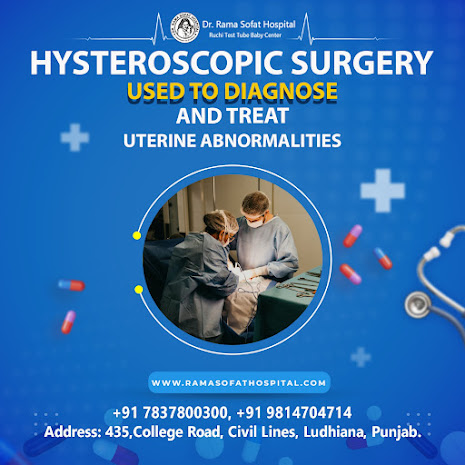Enhancing Women's Health: A Comprehensive Guide to Hysteroscopic Surgery
Hysteroscopic
surgery is a revolutionary medical procedure that has transformed the landscape
of women's healthcare. At Dr. Rama Sofat Hospital in Ludhiana, Punjab, we are
committed to providing top-notch hysteroscopic surgery services to improve the
health and well-being of our patients. In this comprehensive article, we will
explore the world of hysteroscopic surgery, its applications, benefits, and how
Dr. Rama Sofat Hospital leads the way in offering this cutting-edge procedure.
Understanding Hysteroscopic Surgery
Hysteroscopic surgery is a minimally invasive procedure used to diagnose and treat various
gynecological conditions affecting the uterine cavity. Unlike traditional open
surgery, hysteroscopy involves the use of a hysteroscope—a thin, flexible tube
with a light and camera attached to it. This instrument is inserted through the
cervix, allowing the surgeon to visualize the uterine cavity and perform
necessary procedures with precision.
Read: Understanding the Most Common Gynecological Problems and Their Management
Indications for Hysteroscopic Surgery
Hysteroscopic
surgery can be employed to address a range of gynecological issues, including:
1. Abnormal Uterine Bleeding: One of the most
common reasons for hysteroscopic surgery is the investigation and treatment of
abnormal uterine bleeding. Women experiencing irregular or heavy menstrual
bleeding may have underlying conditions such as polyps, fibroids, or hormonal
imbalances that can be effectively diagnosed and treated through hysteroscopy.
2. Polyps and Fibroids: Uterine polyps and
fibroids are noncancerous growths that can develop in the uterine cavity. These
growths can lead to heavy or prolonged menstrual periods, pelvic pain, and
fertility issues. Hysteroscopic surgery offers a minimally invasive approach to
remove or treat these growths, providing relief and improving overall
reproductive health.
3. Asherman's Syndrome: Asherman's
syndrome is characterized by the formation of adhesions or scar tissue inside
the uterine cavity. These adhesions can result from previous uterine surgery,
such as dilation and curettage (D&C), or infections. Hysteroscopic surgery
is a safe and effective method for diagnosing and surgically removing these
adhesions, restoring the uterine cavity to its normal state. This can be
particularly important for women experiencing fertility issues or menstrual
irregularities due to Asherman's syndrome.
4. Septum Resection: Some women are
born with a uterine septum, a band of tissue that divides the uterus into two
compartments. This structural abnormality can increase the risk of miscarriage,
infertility, and complications during pregnancy. Hysteroscopic surgery,
specifically septum resection, allows for the correction of this condition,
improving fertility outcomes and reducing the likelihood of adverse pregnancy
outcomes.
5. Endometrial Ablation: Hysteroscopic
procedures can also be employed for endometrial ablation, a treatment option
for women suffering from heavy menstrual bleeding (menorrhagia) who do not wish
to have more children. This minimally invasive technique targets the
endometrial lining of the uterus to reduce or eliminate menstrual bleeding,
offering relief and improved quality of life.
Read: Maximizing Your Chances of IVF Success: Expert Tips for a Successful Journey
The Hysteroscopic Surgery Process
The
hysteroscopic surgery process typically involves the following steps:
1. Patient Evaluation: Before the
procedure, a comprehensive evaluation is conducted, including a review of the
patient's medical history and any relevant diagnostic tests.
2. Anesthesia: Depending on the
complexity of the procedure, hysteroscopy may be performed with local
anesthesia, regional anesthesia, or general anesthesia.
3. Hysteroscope Insertion: The hysteroscope
is carefully inserted through the cervix and into the uterine cavity. The
camera provides real-time images to guide the surgeon.
4. Diagnostic or Therapeutic Procedures: Depending on the
purpose of the surgery, diagnostic examinations or therapeutic procedures are
performed. These may include tissue biopsies, polyp or fibroid removal,
adhesion lysis, or septum resection.
5. Recovery: After the surgery,
patients are monitored in a recovery area. Patients can usually return home the
same day.
6. Follow-Up: Post-operative
care and follow-up appointments are essential to monitor recovery and address
any concerns.
Advantages of Hysteroscopic Surgery
Hysteroscopic
surgery offers numerous advantages, including:
1. Minimally Invasive: Hysteroscopy is
minimally invasive, resulting in smaller incisions, less pain, and quicker
recovery times compared to traditional open surgery.
2. Precise Diagnosis: The high-definition
camera allows for precise diagnosis and treatment of uterine conditions.
3. Fertility Preservation: Hysteroscopy can
correct structural abnormalities and remove obstacles, improving fertility
outcomes for women.
4. Minimal Scarring: The absence of
large incisions results in minimal scarring and reduced risk of postoperative
complications.
5. Customized Treatment: Each hysteroscopic
procedure is tailored to the individual patient's needs, ensuring personalized
care.
Read: Laparoscopic Surgery for Fibroid Uterus at Dr. Rama Sofat Hospital in Ludhiana
Why Choose Dr. Rama Sofat Hospital for
Hysteroscopic Surgery
1. Expertise: Our hospital
boasts a team of highly experienced and skilled gynecological surgeons who
specialize in hysteroscopic procedures.
2. State-of-the-Art Facilities: We are equipped
with cutting-edge technology and facilities to ensure the highest standard of
care and precision.
3. Patient-Centric Approach: At Dr. Rama Sofat
Hospital, patient well-being, comfort, and confidentiality are paramount. Every
situation is approached with empathy and professionalism.
4. Comprehensive Care: From diagnosis to
post-operative follow-up, we provide comprehensive care, ensuring that patients
receive the best possible outcomes.
Conclusion
Hysteroscopic
surgery is a remarkable advancement in women's healthcare, offering minimally
invasive solutions to a range of gynecological issues. Dr. Rama Sofat Hospital
in Ludhiana, Punjab, stands at the forefront of hysteroscopic surgery,
combining expertise, technology, and a patient-centric approach to provide the
best possible care. Our commitment to improving women's health and well-being
through hysteroscopic surgery reflects our dedication to offering cutting-edge
medical solutions tailored to individual needs.
For any #Infertility related #queries feel free to
or visit us at :
Dr. Rama Sofat Hospital
435, College Road, Civil Lines, Ludhiana, Punjab 141001
www.ramasofathospital.com
 Reviewed by Dr Rama Sofat Hospital
on
4:15 PM
Rating:
Reviewed by Dr Rama Sofat Hospital
on
4:15 PM
Rating:







No comments: